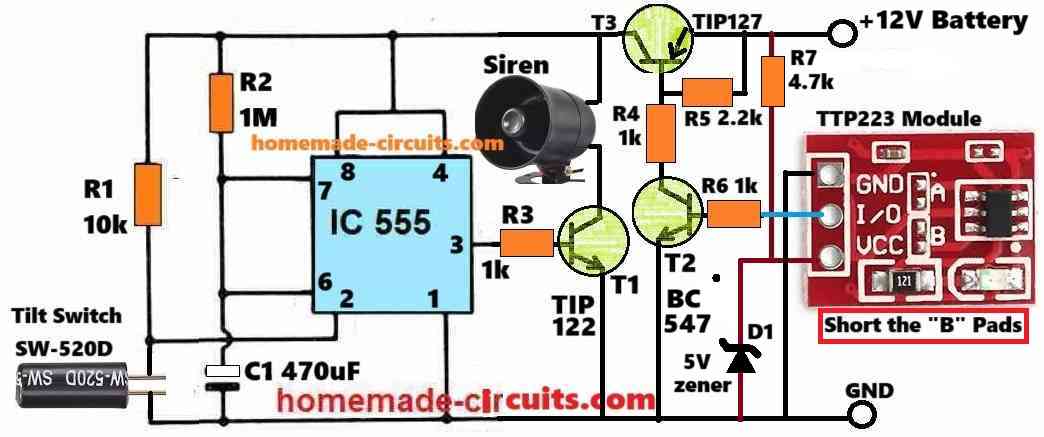In this article I have explained a simple motorcycle ant-theft security alarm circuit using a tilt switch and a TTP223 touch switch.
The circuit was requested by Mr. Sergei, as given below.
Design Request and Specifications
I am a motorcyclist and I would like to ask you to design a simple and cheap alarm system for my motorcycle. For example using a tilt sensor. Maybe with activation/deactivation by touching ttp223 sense pad.
Basic Working Principle
The tilt switch remains activated while it is in the tilted mode or while the motorcycle is parked on its stands and is leaning at an angle. In this mode the owner of the motorcycle powers and arms the circuit through a hidden TTP223 touch switch module.
In this situation if a thief tries to steal the bike by removing it from the stand, the motorcycle is aligned horizontally straight, causing the tilt switch mercury to changeover.
The internal changeover of the tilt switch instantly toggles ON an IC 555 monostable and an attached siren.
The siren sounds alerting the people around, and the owner regarding a possible motorcycle theft.
Circuit Description
The following figure depicts the complete circuit design of the motorcycle anti-theft alarm circuit, using tilt switch and TTP223 module.

The working of the proposed motorcycle anti-theft alarm circuit can be understood with the following points:
The TTP223 is configured as a touch ON/OFF toggle switch.
When the motorcycle is parked and leaning on its stands, the TTP223 is activated by the owner, by touching the touch pad on the reverse side of the module.
Once toggled ON, the OUT pin of the TTP223 module sends a positive voltage to the base of T2 turning it ON.
With T2 turned ON, T3 is also turned ON, and T3 now powers ON the IC 555 circuit.
The IC 555 is configured as a monostable multivibrator. In this configuration, the IC 555 generates a momentary high logic at its pin#3 whenever its pin#2 is grounded.
The time for which this momentary logic high at pin#3 stays active depends on the values of R2 and C1.
This logic high becomes responsible for activating the T1 and the alarm siren.
Now, as stated above, pin#3 of the IC 555 goes momentarily only when its pin#2 is grounded.
As shown in the diagram, a mercury tilt switch SW-520D is connected between pin#2 and ground.
While the motorcycle is parked on its stands and inclined at an angle, the mercury inside the tilt switch rolls down at one end of the tube.
This keeps the contacts of the tilt switch disconnected internally, so that pin#2 of IC555 stays disconnected from the ground.
Now suppose, an unfortunate thief attempts to steal the motor bike and in the process pulls the bike vertically straight.
As soon as this happens, the mercury inside the tilt switch flows across the other end and shorts its internal contacts.
This instantly grounds the pin#2 of the IC 555 causing its pin#3 to go high, switching ON T1 and the alarm.
The burglar may try a desperate attempt to restore the motorcycle back to its original position, but that won't help to stop the alarm.
Depending on the values of R2 and C1, the alarm remains activated for some time and then it stops automatically.
By the time the alarm stops, the owner is already alerted regarding the situation so that he can quickly respond to the situation.
Parts List
- Resistors are 1/4 watt CFR 5%
- 1k = 3
- 10k, 1M, 2.2k, 4.7k = 1 each
- Semiconductors
- Transistors TIP122, TIP127, BC547 = 1 each
- IC 555 = 1
- TTP223 module = 1
- Tilt switch SW-520D = 1
- zener diode 5V 1/2 watt = 1
1. I will assume that 2 – 5.5 V DC is needed to power the TP223 module. However, this is not a problem, it is easy to add an LM7805 Linear Regulator LM7805 or similar to the power supply circuit.
2. Does the siren sound continuously or intermittently?
3. Where in the circuit can I add a ‘breathing LED’ circuit on ne555 as an arming indicator?
OK, here are the answers:
1.Yes 5v can be used through a 7805 ic for the ttp223, or through a zener/resistor network.
2.The siren sound will continuous but if an intermittent type siren is used the sound will be intermittent. However the siren will be on only for sometime depending on the values of R2 and C2.
3.You can connect a 555 based breathing circuit directly across the supply terminals of the existing alarm circuit.
Dear Swagatam! Thank you for the solution and for the article!
Thank you Dear Sergei! Its my pleasure!